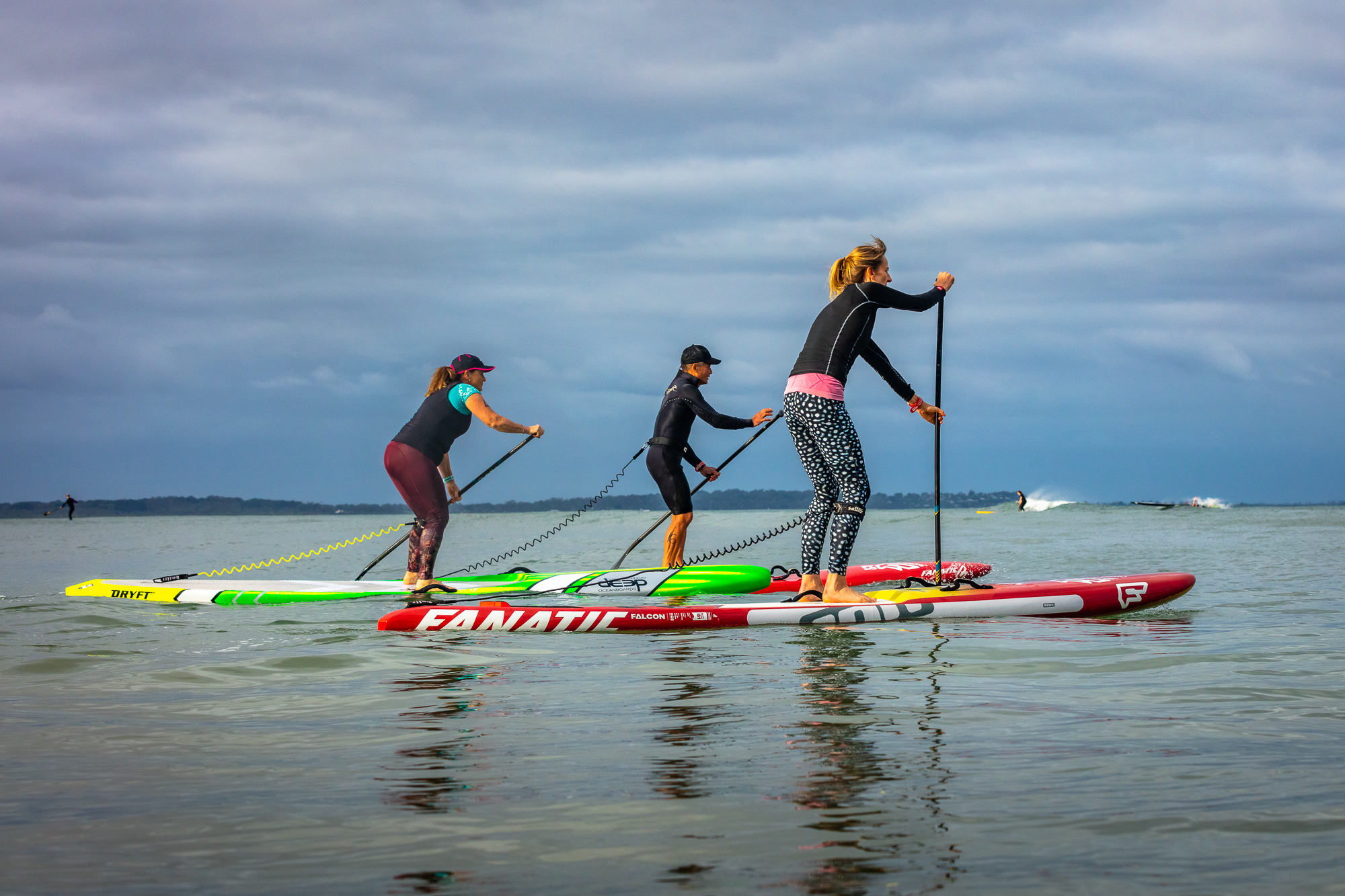NEW TO STAND UP PADDLEBOARDING?
Check out these 3 Essential Rules for SUP Paddling Safety.
IMPORTANT ‘MUST-KNOW” SAFETY INFORMATION FOR SUP PADDLERS


3 Essential Rules for Stand Up Paddleboard Beginner Safety
If you are new to SUP paddling and or have little experience paddling in bays and the ocean, please read on for some important ‘must-know’ information before you next hit the water. There’s also some great reminders and tips for those with a little more experience!
SUP paddling is a lot of fun, but things can turn bad very quickly if you aren’t aware of the following 3 Essential Rules for SUP Paddling Safety.
They are:
- Always wear a leg rope,
- Know the wind strength, direction and overall conditions – plus what it means, and
- Know your limitations
Rule 1 – Always wear a leg rope.
Your board is a perfect flotation device in emergencies – your leg rope keeps it close to you! If you fall off your board without a leg rope and the wind is stronger that about 10 knots, you will NEVER catch-up to it swimming. It will always float away with the wind faster than you can swim. So, always wear a leg rope as it is the ultimate safety device for SUP paddlers.
Rule 2 – Know the wind strength and weather.
If you combine strong winds and a ‘bad’ wind direction, things can turn bad very quickly. Check your local weather for not just when you plan to go paddling but 1hr either side as well. Check the weather for where you plan to paddle, not your home. There can be a big difference!
Wind strength: Look for gentle (less than 10kts or 15km/hr). If the wind is greater than 10 knots, you will struggle as the wind creates chop and waves. Even in light winds, always paddle into the wind first. When you turn around the wind will then help push you back to your starting point. Over time your paddling skills and understanding of the weather and conditions will improve.
Wind direction: Find a beach, time or day when the wind is blowing on-shore (from the water to the beach) for your paddling. When paddling a SUP, you are pushed along very quickly by wind. If the wind is blowing off-shore (blowing away from the beach and out over the water), do not go out. An offshore wind can blow you away from the shore very quickly, and gets stronger the further away from shore you get! It’s also a little tricky – it can feel very calm on the beach even when an off-shore wind is ‘strong’ (anything over 10kts or 15km/hr). This is because the beach is protected but, once you get 20 meters or so from the shore you may find that the wind is so strong that you cannot paddle against it to return to land. So, if the wind is not blowing at least partly on-shore, new paddlers should not venture out a SUP.
Conditions: BEFORE you set out for the beach check both the present conditions (wind strength and direction) and the forecast conditions for the next few hours at the very least. If the wind is off-shore or more than about 10 knots – don’t worry about taking the SUP! Many people have headed-off on a calm morning only for the wind to ‘spring-up’ not long after they arrive at the beach. That said, wind rarely ‘springs-up’! A few minutes checking the wind forecasts of strength and direction can be the difference between a fun time and a potential disaster. There are a number of apps along with the Bureau of Meteorology website that will give you the current wind speeds (standard and peak gusts) and direction as well as those forecast for the remainder of the day. It is essential that you know what the wind is doing before you hit the water. The forecasts will tell you when the morning’s calm conditions will change and may fast become unsuitable for new SUP paddlers.
Rule 3
Know your own SUP limitations – ie, your SUP paddling skills and abilities. SUP paddling is easy in extremely calm conditions when you can simply enjoy the scenery. To venture out in less ideal conditions takes time. Also consider your swimming ability, never paddle further from shore than you are able to swim. Give yourself time to develop your SUP fitness and your SUP paddling skills and always pay attention to how far away the shore is – at the start, stay very close (20-30m)! Many people have trouble standing on the board the first few times they use it, particularly if the water is a little chopped-up. Be prepared to take some time to learn the balance skills and to develop your paddle fitness. If the conditions look a bit rough on the water, it is not the time for beginners to be out on a SUP board. And even in the best of conditions, when new to SUP, don’t venture out more than 20 -30 meters from the shoreline.
What to do when you are caught in unexpected strong winds
If you are accidentally caught in strong winds that are beyond your paddling capabilities, then:
- Don’t panic. You should be wearing a leg rope, so if you do get tipped off your board, it will always be there for you. Pull it to you and climb back on (practice this in shallow water!).
- If the wind is too strong to paddle against standing up then get down on your knees and paddle.
- Don’t aim to get back to the beach where you started from. Angle your paddle back to shore so that you aren’t directly fighting the wind. This can limit the wind’s impact on you and you will come ashore a kilometre or so down the beach; it is far easier to do that and walk up the beach dragging your board behind you with the leg rope than to try to reach your starting point.
- Even though you are on your knees, you still create a decent sized ‘sail’ for the wind to catch and push you down wind. If this is the case and you are still not making headway, then lay on your board and tuck the paddle blade under your chest so that the paddle shaft and handle is in front of you and angled upwards away from the board. This limits you ‘sail effect’ to an absolute minimum whilst still staying on your board. Then simply employ a freestyle swimming stroke with your arms to head in the desired direction.
Final Considerations:
- Make sure you know how to climb back on to your board when out of your depth. Practice close to sure if necessary.
- Consider paddling with a mobile phone in a waterproof phone case.
- Consider joining SUP Vic (Stand Up Paddle Victoria) so that you can frequently paddle with other SUP paddlers. This will greatly enhance and speed up the development of your SUP skills and fitness.
Once again, SUP paddling can be a really fun activity that can be done by all family members, as long as you follow the 3 rules above. SUP can be a great summertime leisure activity on the beach through to a great fitness sport and even SUP racing for those so inclined. Do the right thing in accordance with those rules and you will definitely have a fun time with a fun sport/activity that will see you progress your skills quite quickly.
FOOTNOTE:
If paddling a SUP 400m from shore, regulations dictate that you MUST wear a personal floatation device (PFD). All children Under 10 MUST wear a PFD when on a SUP, irrespective of how far they are out from the shoreline. Finally, never leave your children to paddle on their own. Always keep a close supervisory eye on them at all times.
Disclaimer
The Committee of SUP Vic provides this message to you for your information only and nothing contained on this page is to be construed as providing legal advice on the operation of the safety laws in force in Victoria as they apply to stand up paddle activities.
